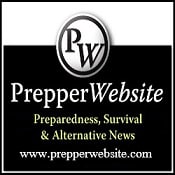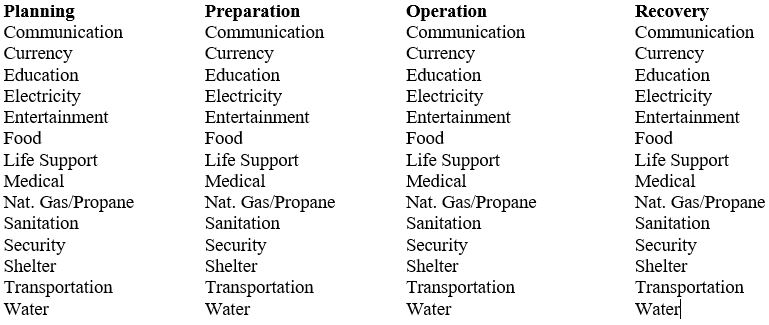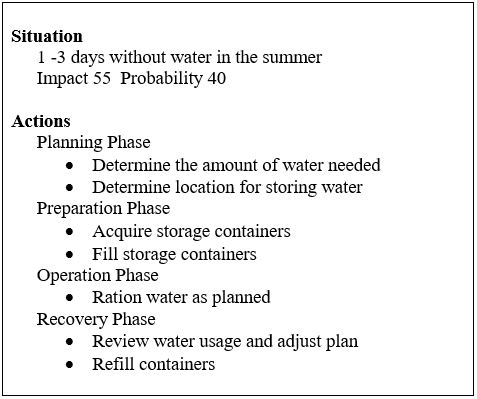Why Make an Emergency Response Plan
At some point, nearly everyone is faced with an emergency situation. It can be the loss of electricity for a couple of days, a boil order on your water or something more cumbersome. I knew someone who was displaced by Hurricane Andrew, in 1992. After learning of her ordeal, I began researching emergency preparation. All resources that I researched advised making an emergency response plan.
Over the past three years, my town has experienced an ice storm, boil order, active shooter and a couple of floods.
Some of these situations were predictable. In the case of the ice storm, the population converged on the grocery stores to stock-up on supplies. During the boil order, there was a run on bottled water. It was amusing to drive past the stressed “last-minute preppers” circling the parking lot in search of an open space. There wasn’t enough bottled water for a town of 56,000 people on short notice. Having an emergency preparation plan provides confidence and reduces anxiety. Developing an emergency plan can be a painless and rewarding exercise.
You don’t need to look far to recognize the need to plan and prepare for emergencies. When you focus on emergencies that are relevant to your circumstances, planning can be manageable. In a 2012 Colorado wild fire, a couple was burned in their car, still in the garage. That tragic loss needs to serve as a lesson to everyone. Having a plan to evacuate your home can reduce the time to evacuate. Minutes can mean the difference between life and death.
Most emergency preparation resources advise making a plan. I didn’t find much information about making a plan, so I developed my own methodology and created a database to help manage my emergency preparations. My planning begins with identifying situations that I want to address. Then I prioritize the situations. After selecting the top priority situations, I develop action steps to address the situation. The set of actions for a situation creates a standard operating procedure, or SOP. The SOPs are stored in a three-ring binder. My plan is the collection of SOPs.
This planning methodology may seem different than typical emergency response planning, because little in attention is paid to the triggers or causes of situation. If you experience an interruption in electricity service, it really doesn’t matter what caused the interruption. The interruption can be caused by a lightning storm, a car crashing into a utility pole, a terrorist shooting a transformer or any other cause. The situation is; you don’t have electricity. So, there isn’t a SOP for tornado, hurricane, flood, wild fire, etc. The SOPs are for the situations caused by those events.
In some cases, an event will require several SOPs. An ice storm can leave you quarantined in your home without electricity. In that case, you would use two SOPs, one for being quarantined and one for being without electricity.
A couple fundamental terms are:
A Situation is a condition, service interruption or undesirable state that should be mitigated
An Action is a task to mitigate a situation
Situation
As you consider your needs, rate the situations for their impact and probability. Based on that information, the situations can be mapped on a matrix. The matrix can be used to help prioritize the situations for which you develop mitigating actions.
Matrix
Action
Actions are organized by phases and categories. In this article, actions and action steps are used interchangeably.
Phases – There are four phases in this methodology – planning, preparation, operation and recovery
Categories – Each phase is organized into fourteen categories
In defining Actions, it is useful to define the five basic interrogatives:
- Who
- Where
- When
- How
- Why
Anything that isn’t covered by that framework, can be added to the notes section.
Some Actions can be used to mitigate multiple Situations. For example, I include an action to record improvement ideas in each SOP.
Begin
A logical starting point is identifying the situations that you want to address. You may want to consider your exposure to natural disasters, medical needs, civil disasters and other situation triggers. Examples of situations can include:
- Electricity service interruption for 1-3 day in the summer
- Service interruption of medical oxygen supply for 1-3 days
- Quarantined to your house 1-3 days in the winter
Estimate the impact and probability for each Situation.
Once the Situations have been calibrated with impacts and probabilities, plot them on a matrix – see example above. The high-impact/high-probability Situations are presented in the upper right quadrant. They may be the highest priority.
Using the Threat Matrix, select the Situations that you should mitigate. For each situation that you want to address, identify the action steps that will mitigate the situation. As explained above, the combination of a situation and action steps forms a standard operating procedure, or SOP. It’s helpful to store your SOPs in a binder. This is your emergency response plan.
SOP Example:
Advanced Planning Techniques
It is important to balance your resources, especially time and money. Planning and preparing for emergency situations requires both of those resources. Decisions about using these resources are made for each action step. To help make these decisions, you can assign proficiency levels for each action step. Identifying the important actions and establishing target proficiency levels can be used to know where to focus your resources.
Actions can include target proficiency and status levels. Target proficiency levels include:
- Minimum
- Good
- Better
- Best
- Exemplary
- Not Applicable
Some actions may be more critical than others. It may be beneficial to develop higher proficiencies in the more critical actions. Since water is critical, that may be an area in which to develop higher proficiency. That could include high proficiency levels in:
- Determining the amount of potable water needed
- Determining storage methods for potable water
- Storing potable water
You can track your proficiency levels by self-estimating your percentage of the proficiency level – from 0 to 100%. If you determine that you have achieved the proficiency level for an action, you can stop spending time and money on that action.
Emergency Response Plan – Not Shelfware
This planning methodology includes four phases. The first two phases are intended to help you to plan and prepare proactively for emergencies. Having the binder of SOPs, your emergency response plan, during an emergency situation is comforting and useful. However, you need to use the plan before the situation develops. For example, if there is a quarantine order, such as the one that followed the Boston Marathon Bombing, you need to have already completed the planning and preparation action steps before the order. You can’t always predict emergency situations, so you have to prepare in advance.
Planning Software
My professional life has been creating commercial software applications and databases. That led to the development of Prep Smartz. It is a software application provides the framework and examples to assist in preparing for emergency situations. With it, you can prioritize the situations that are relevant to you, and develop actions to mitigate the impact. The action items can be grouped into Standard Operating Procedures and printed for storage in a binder.
 |
By Roger Eaton Over thirty years of experience in information technology and over seventeen years of experience in emergency services converged to inspire Eaton to develop Prep Smartz, emergency management software and Prep Smartz Academy. |





